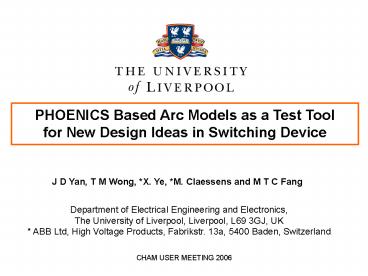Computer Modelling of Atmospheric Arcs PowerPoint PPT Presentation
1 / 15
Title: Computer Modelling of Atmospheric Arcs
1
PHOENICS Based Arc Models as a Test Tool for New
Design Ideas in Switching Device
J D Yan, T M Wong, X. Ye, M. Claessens and M T
C Fang
Department of Electrical Engineering and
Electronics, The University of Liverpool,
Liverpool, L69 3GJ, UK ABB Ltd, High Voltage
Products, Fabrikstr. 13a, 5400 Baden, Switzerland
2
BACKGROUND OF WORK
- Liverpool group has long been engaged in
atmospheric plasma research in industrial devices
such as high voltage switchgear, welding and
cutting, material processing and nano-materials
production. - PHOENICS has been used in Liverpool for 14 years.
Currently we are using version 3.4 and 3.6.1
3
AN EXAMPLE OF CIRCUIT BREAKER
- At high current, vapour from nozzle surface
pumped into storage volume to form a high
pressure reservoir (fig. on right). - At current zero, fast gas flow into nozzle
quenches the arc, thus interrupt the current .
Vapour flows towards storage
Ablating surface
Current
4
UNDERSTANDING THE KEY MECHANISMS
- Capability of PHOENICS to handle the
implementation. - Surface ablation represented by mass, momentum
and energy surface sources. - Arc current interact with its magnetic field
(Magnetic pinch effect) is represented by
momentum source. - Ohmic heating and radiation are treated as
volumetric energy sources. - Numeric implementation of moving contact (fig.
below) and operation of valves.
5
DIFFICULTIES WITH ARC MODELLING
- Temperature in the range from 300K to 35000K and
with steep gradient (upper fig.). Material
properties are highly nonlinear. Pressure ranges
from 0.2bar to 100bar. Density changed by order
of magnitude. - Radiation is operating. Very strong emission and
absorption in thin layer. - Flow field is very complex (lower fig.). Shock
waves exist in part of the domain. - Implications on convergence and relaxation.
2D Axisymmetric Arc Model
6
SPECIAL SCHEMES
- To improve and maintain convergence, we used a
multi-zone false time step for relaxation of
momentum and energy equations. The division of
the zones is mainly based on density and energy
source term - For heat source
- Zone one 300 10000K
- Zone two gt10000K or volume energy source higher
than 108 J/(s.m3). - Arc electrode interaction. Difficulty was that
arc did not following the movement of the
electrode. Special coding was introduced in
ground to tackle this problem.
7
WHAT WE HAVE ACHIEVED
- An arc model that applies to a range of
industrial plasma devices which produce
realistic, reasonable results within acceptable
time. - Can simulate the operation of the arcing process
and the movement of the mechanical parts. - Implementation of all important physical
mechanisms. - Use of Liverpools arc model for optimization of
design and test of new ideas.
8
VERIFICATION OF RESULTS
Current (A)
Pressure (Pa)
Current (A)
Test result
Current (A)
Simulation
Comparison with test results for an
auto-expansion circuit breaker.
9
INFLUENCE OF DESIGN PARAMETERS
- Circuit breaker design is expensive.
- To produce results matching measurement is only
the first step. - Complicated phenomenon, such as fast pressure
transient, was observed and identified as an
important aspect of circuit breaker design.
Reasons for pressure transient are to be
identified. - Aim is to answer the whys and hows in circuit
breaker design. For example if we change a design
parameter how the arc behaves differently?
Beneficial or adverse effects on circuit breaker
performance.
10
INFLUENCE OF DESIGN PARAMETERS
Results are compared for pressure at point D
which is an important location.
11
INFLUENCE OF DESIGN PARAMETERS
Arc column shrinks rapidly near current zero,
thus creating low pressure region. This process
races with gas from high pressure reservoir.
Influence of length of heating channel
12
INFLUENCE OF DESIGN PARAMETERS
Influence of internal structure
13
TO TEST NEW DESIGN IDEAS
GOOD OR BAD IDEAS?
14
TO TEST NEW DESIGN IDEAS
GOOD IDEAS?
15
WHAT CAN BE DONE FURTHER
- On fundamental level, we need a more accurate
radiation model for gas mixture of SF6 and PTFE. - Convergence problem is not fully solved,
especially with skewed grids (BFC). - On PHOENICS side, parallel computation for speedy
simulation, unstructured grids for 3D simulation.
- Associated issues such as calculation of electric
field and radiation transfer etc in unstructured
grid system. - Post-processing.

